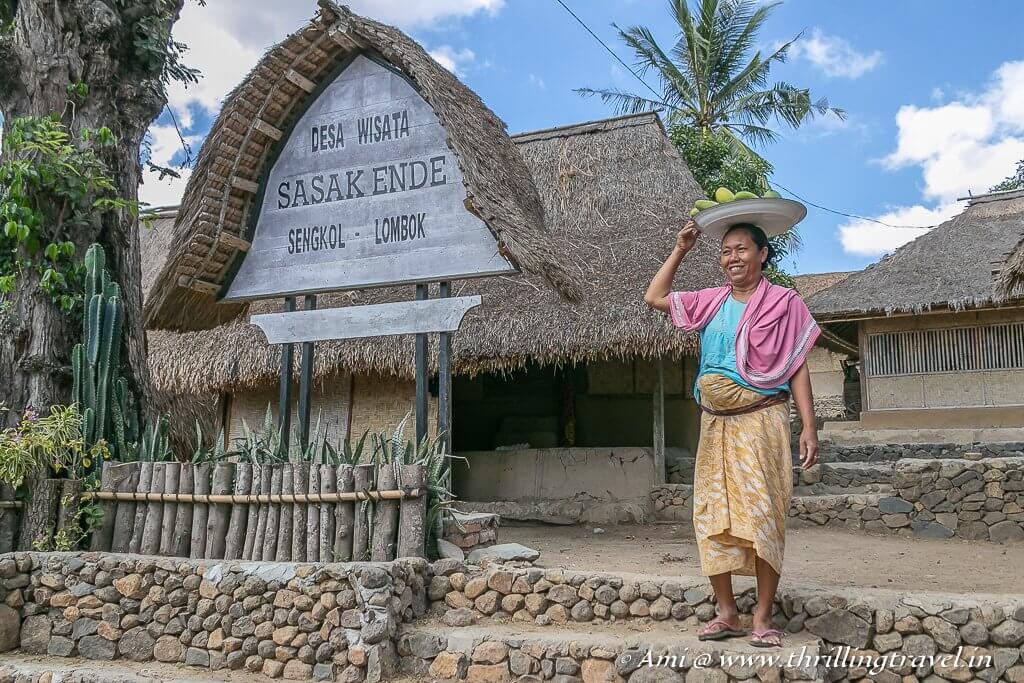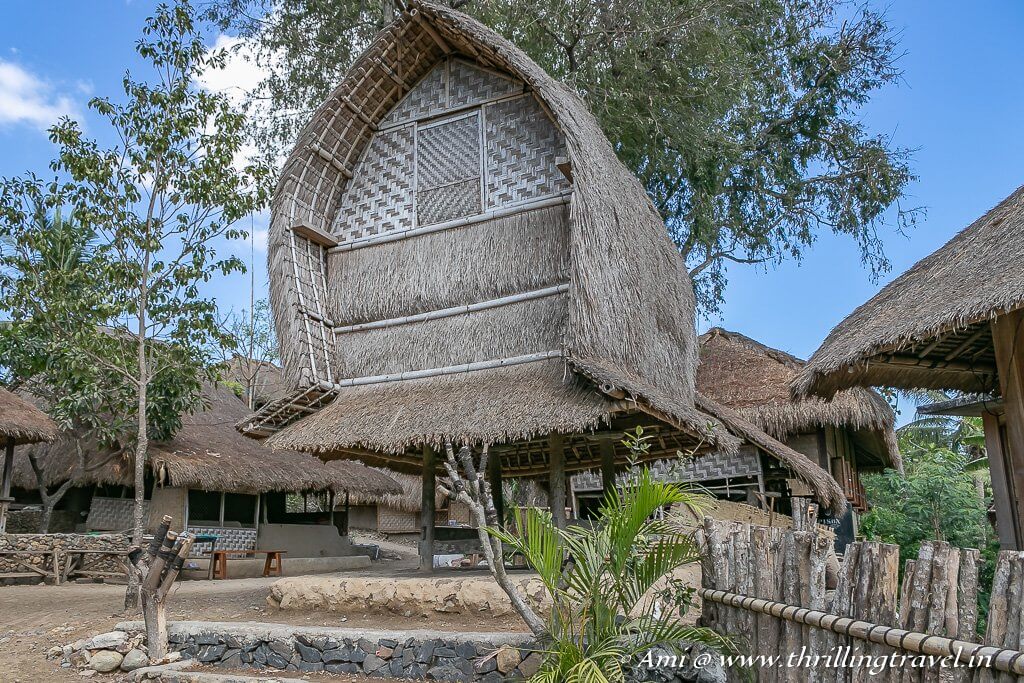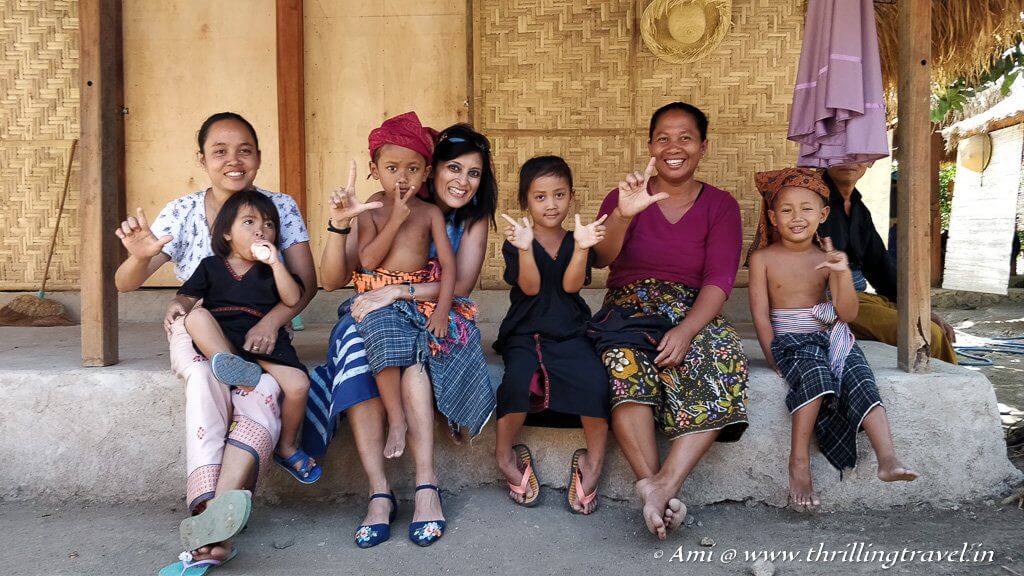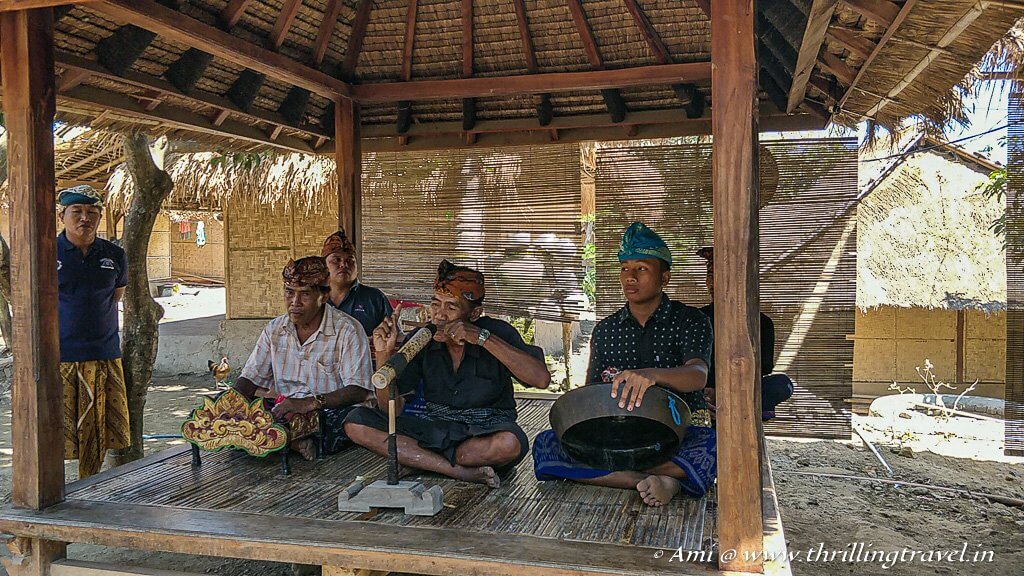It is not just nature that makes Indonesia a desired destination for travelers. It is the classical fusion of natural beauty with its unique culture that attracts visitors to Indonesia. Over my last trip, I discovered the Balinese culture and how it had similarities to my own Indian culture. This time, I uncovered a different slice of the Indonesian culture with a visit to a traditional village in Lombok. The Sasak village in Ende opened their humble homes for us to explore, entertained us with their heritage tales and showcased the various traditions of their hamlet.

A tour of the Sasak village is an almost unmissable Lombok attraction. It was my own visit to the Sasak village in Ende that made me realize why. The Sasak have been natives of this island for over 2000 years and with such ancestry, they have charming secrets of their own. These are what they revealed upon my visit to the Sasak Village. It is uncovering these secrets of a Sasak traditional village that will make you add it to your Lombok itinerary.
Contents
History of the Sasak Villages in Lombok
It has been so long since the Sasaks first settled in Lombok that the first trace of their history has been lost. It is believed that the Sasak people were actually Balinese who migrated to Lombok and made it their home. Some traces of this can be seen in the way their homes are made and in the Sasak language itself. They practiced their own religion until the 17th century when a majority of them were forced to convert to Islam. However, some of these tribes still retained some of their Hindu beliefs and created a new subsect called Wetu Telu.

Today, a lot of the Sasak villagers, especially the younger generation have moved to towns for a better lifestyle. However, there still exists a sizable number of villages where people still have a simplistic Sasak lifestyle. They still have the typical Sasak homes and speak in Sasak language. It is these villages that have now become important tourist attractions of Lombok. One can find them scattered across the island and the one that we visited was in Ende, in South Lombok.
Structure of a Sasak Village

The Sasak Ende Village that we visited had around 35 homes. Interspersed among these homes, were cow sheds and a large square that doubled up as an amphitheater. Rising up in those rows of homes, were tall barns called Lumbung. A Lumbung was used to store the rice and is constructed on a higher level than the homes for various reasons. Made with mud and buffalo dung (specifically on the floor), they have a single opening and are made in a manner that prevents rodents from entering and destroying their produce. Besides the Lumbung, a small structure called the Musholla which was used as the prayer room. None of the homes of a Sasak village face towards the Mount Rinjani. It is believed that the orientation away from the mountain gives respect to their ancestors.

The courtyard or the main square had a shelter for the village meetings to take place. A typical Sasak village has an elder, revered for his experience and knowledge. Sometimes, it is not just one elder but a few of them. While it is the leader who decides the best for the village, he still seeks the counsel of the Sasak Village elders. Besides ensuring the well-being of the Sasak village, a leader is also, responsible for keeping the heritage of the Sasak Village intact and alive.
Bale Tani – the traditional Sasak Home

The first thing that is bound to capture your attention in a Sasak village is the homes of its residents. Called the Bale Tani (Bale means house and Tani means farrmer), these houses are made using wood, bamboo, grass, cow dung and mud – all-natural material from around the village. While the wood and bamboo make the walls of Bale Tani, the Alang-Alang grass makes the roof of the homes. The earthen floor of the homes is polished with cow dung for two reasons. The scientific one is that it keeps away the mosquitoes while the traditional belief is that what comes from earth must return to it.
Our guide at the village pointed out to the doors of a Bale Tani. They are quite low and even a midget like me had to bow down to enter the home. He explained that the reason for the same was to show respect to the world and its people around.

Upon entering a Bale Tani, you will see a simple single and large room that is just divided into sections by its bamboo pillars and possibly a make-shift curtain. Small shelves along the walls took care of their storage needs as did a cupboard or two. Typically, after marriage, a couple stayed inside the home together until the first child is born. After that, the man of the house shifts out and sleeps outside the house on the porch while the women and kids sleep within. The kitchen of a Bale Tani is a separate construction – albeit a smaller one that is attached to the main house. Most of the food is made in the traditional olden style over firewood.

A typical Sasak family (occupation, food, clothing)
With the meaning of Bale Tani, you would have guessed that the key occupation of the Sasak tribe is farming. They mostly, cultivate rice, which also, doubles up as their main food. However, the occupation of the villagers is not just limited to males. In fact, it goes beyond to the ladies of the village. Every female has to learn weaving else she is not allowed to get married. 😉

The women are adept in this art and when you walk around a Sasak tribal village, you will find them working on Songket and Ikat designs. These colors used in the weaving threads are all from natural sources like Betel nuts and Indigo. A typical weaving process could take anything between 2 to 3 months on the traditional looms that you will witness around. You can choose to buy some of the pretty shawls or dresses from them while you are here. The prices are fairly reasonable and they do help the village maintain its heritage.
Sasak Customs & Traditions
I have already shared the Sasak beliefs regarding their homes, their orientation and the way they use it. Time to share an interesting custom called Merariq. Merariq refers to an eloping custom followed by the Sasak people. It is customary and pretty normal for the Sasak men to kidnap their women and disappear for a few days. The eloping couple stays in a close family home till the parents are ready to negotiate and officially marry off the girl.

The negotiation generally happens in the presence of the village elders. While the tradition still exists, it is not being practiced as much. Guess the era of modernization has set in even in these Sasak villages. As for the other interesting traditions, check out the next section.
Peresean Dance in the Sasak Ende Village
If I had to point out a highlight of my visit to Sasak Village, then it would be witnessing the traditional dance called the Peresean dance. Performed in the central village square, this is a martial art dance form that is generally performed before the harvest season. It involves two warriors called Pepadu and a referee called Pakembar. The warriors are armed with a long wooden stick and a shield that is made from Buffalo skin. The shields are also, referred to as Pepadus – possibly why the warriors are called so.

As the Pakembar blows the whistle, round one starts with the two warriors attempting to hit the other with the sticks. The crowd cheers for their favorite Pepadu and tension builds up as one jumps through the air to attack the other. A few blows and the Pakembar blows his whistle to send each Pepadu back to his corner for a brief rest. The rounds continue till one of them draws the blood of the other. The Sasak belief has it that when the blood falls onto the earth, it will rain well for the harvest. In fact, more the bloodshed, better the rainfall. However, that with modern times is no longer practiced and what you will see it just a friendly version of the duel.

The rhythmic moves of the fighters are accompanied by a band of musicians. The Sasak music here is called Baleganju and involves gongs called Gengong, a large drum called Gendang Beleq, cymbals called Ceng Ceng and a very unique wind instrument called Suling. Our guide mentioned that this special flute – Suling was made from Palm leaves and required a different kind of skill to make that unusual sound. It was a part of almost every Sasak music, almost like a signature tune.



The Sasak people are quite dedicated in their efforts to keep their values and traditions alive. You will see not just adults treating you to a Peresean dance but also, kids. Dressed in traditional attire, these kids attempt to knock the other out with smaller Pepadus. Personally, I found the same to be the cutest. The same kids kept following us around and also, entertained us with their smatter of local poems including one that involved the words Wonderful Indonesia.

A visit to the Sasak Ende Village showcased a different side of Indonesia to me. The genuineness of the Sasak people and their manners won my heart. They not only opened the doors of their homes for me to see how they lived but also, personified the belief that the most beautiful thing about the world lies in its simplicity. If you are ever in Lombok, you must visit one of these traditional Sasak Villages. And to help you do so, just bookmark this guide with the pin below.

How to get to the Sasak Village in Lombok?
- Lombok has its own airport with decent connectivity to international destinations like Singapore and Kuala Lumpur. There are a number of domestic flights from Indonesian airports like Bali and Jakarta to Lombok.
- You can opt for a ferry transfer from Bali and nearby islands to Lombok. You can book one right here through this link.
- There are numerous Sasak villages in Lombok. The two famous ones that are frequented by tourists are in Sade and Ende. My experience here is that of the Sasak Ende Village. This village is conveniently located en route to the Kuta Lombok beach. It is just 15 minutes from Lombok airport.
- To get to the Sasak Ende Village, you can either opt for a self-drive car, a taxi or even hire a two-wheeler. In case you are looking at booking a tour online with a hotel pick-up, consider buying it through this link. This tour also, includes a visit to some waterfalls and other landmarks of Lombok.
When in Lombok, you must consider visiting the divine Benang Kelambu Waterfalls. You will feel as if you have stepped into paradise. Don't believe me? Check it out for yourself through my own this link
Travel Tips
- There is no entry fee for the Sasak Ende Village. However, at the end of your tour, it would be nice to give the Sasak village guide a token tip. The money given to him goes towards maintaining the village.
- The Sasak villagers are quite friendly and open. They will be happy to let you into their homes. While doing so, please be respectful of their privacy.
- Keep aside at least one hour for your visit.
- There are public restrooms at the Sasak Ende Village.
P.S: I visited the Sasak Ende Village as a part of my #WonderfulIndonesia trip with Malindo Air and Indonesia Tourism Board
Disclaimer: This article includes affiliate links. This means that at no cost to you, I will receive a small commission if you purchase through my link. Thank you for supporting me with this.
Popularly referred to as a Restless Ball of Energy. My Mom refuses to entertain my complaints about my equally restless daughter & assures my husband that I was born with a travel bug.
I am a Post-Graduate in Marketing by qualification and a travel blogger by passion. Besides travel, I enjoy photography and if you don’t find me at my desk, I would be out playing badminton or swimming or just running. I believe in planning for every long weekend through the year. And when I cannot travel physically, I travel virtually through this travel blog. My travel stories have also, got published on various websites and magazines including BBC Travel, Lonely Planet India and Jetwings. I have recently published my first book – When Places Come Alive – a collection of stories that are based on legends, landscapes, art and culture of a place which is available in both ebook and paperback format.


Such an informative post. The pictures are amazing Ami 🙂
Thank you Antarik. The guides we had were amazing in sharing these bits about the place and the customs and people
Interesting post, was worth the time reading it 🙂
Thank you Amit. That makes my day.
I would love to go to Lombok!! This sounds like a lovely thing to do on the island. Thanks for the tip about tipping the guide at the end.
Glad you found it interesting Anna.
The combination of beautiful natural landscapes with a unique culture is certainly a draw for me to visit Indonesia, and Sasak Village looks like a good option to experience this. The homes are quite unique and seeing local craft and performances appeals.
Nothing better to figure out the culture of the place than to go to the actual homes. Bet you will figure out Sasak Village has more than what you expected.
How beautiful Ami. You just gotta love Indonesian culture in more rural areas. The garb, the customs. This is why I love more rural Bali so much. Indonesia is exotic, warm, friendly and inviting. Fabulous post!
Ryan
Thanks Ryan. Lombok was such a pleasant change from the little crowded Bali. Plus the culture is definitely different .
For me, yes, I would love to check out the culture of the locals but as I love checking out archiecture, I would love to see these buildings. I haven’t come across anything like this one my travels and to combine it with the nature, they look amazing. Great post Ami and thank you for sharing us your insight of the Sasak Village.
Thanks Danik. I am pretty sure you will find a visit to this village illuminating and fun too!
What a beautiful village. I haven’t heard of it before but thanks for sharing it! The traditions are very interesting.
Glad you found the traditions interesting. Thanks for stopping by Stephanie
It’s a well-written text. I read it like a novel! Well described culture and customs, traditions of the Lombok inhabitants. Only 35 homes in the village, and such richness culture. I always like to get to know local music during my trip. I often bring records from my holidays. I’d love to listen to this music and see Peresean dance you describe so lovelily. I would like to see traditional unique Sasak home, too. Indonesia has been on my bucket list for a long time, and I will visit Sasak Village, also.
Thank you Agnes. Am sure a visit in person would make the place even more interesting for you.
Wow, just seeing the Lumbung and home structures of the Sasak village is a singular cultural experience. It’s always amazing to see how every little detail was thought through (like the height of the Lumbung away from rodents) and accounted for even without major technological advances. These are the truly authentic travel experiences and stories that I love!
Thanks Kate. There is plenty in the village that I found captivating. They sure know how to get along without technology
Interesting post and awesome pictures Ami.. Thanks for sharing us!!!
Thanks Mary. Am glad you liked it
I too agree that knowing culture of a place is as interesting as seeing the sights of attractions. Indonesia has great culture and it is also similar to our Indian culture too. Good to see those homes of farmers which are made up of bamboo, wood, cow dung and dry grass. I love Ikat designs and it would be great to see those tribal women weaving beautiful Ikat patterns and using the natural dyes made by betel nut and Indigo.
Knowing the culture of a place is what gives flavor to the place. Am glad to have caught the Sasak culture . Made me appreciate and enjoy Lombok better.
what a great post!! I always loved those tribal residents of Indonesia. I think these attractions are far more interesting than other touristy activities Indonesia has to offer. I love those ethnic hay houses and I would love to spend a night or two in one of these stays. This was the first time I heard about beetle nuts it looks something that local people love to chew on.
Betel nuts are pretty common in India and guess that is the case in this part of the world too. They are they ones that give your teeth and mouth that red color. 🙂